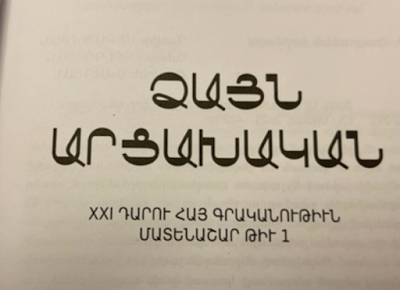Վահէ Յ, Աբէլեան
Պարզապէս բառի մը մասին է գրերլիքս։ Բառ մը որ հանիպած էի աւելի քան վեց տասնամեակներ առաջ։ Քանի որ օր առաջ կրկին անգամ հանդիպեցայ նոյն այդ բառին։ Այս անքամ ալ քաղաքական ակնարկով մը գործածուած էր։ Բայց իմ պատմելիքս պարզապէս այդ բառին իմ պատմութիւնս է, ուրիշ ոչ մէկ բան։
Քանի մը օր առաջ Արմէն Մխիթարեանը (Armen Mkhitaryan), ֆէյսպուքի իր էջին վրայ զետեղած էր լուսանկամր մը հետեւեալ նկատողութեամբ ՝«Արմաշկաներ, այս նկարին շատ լավ նայե՛ք»։ Զանծ կ՚առնեմ զետեղել այդ լուսանկարը պարազապէս որպէսզի այս գրութիւնը «Արմաշկան» բառին իմ պատմութիւնս ըլլայ եւ ուրիշ ոչ մէկ բան։
«Արմաշկան» բառը զիս ետ տարաւ աւելի քան վեց տասնամեակներ, պատանեկութեանս օրերուն, երբ կարդացի Մալխասին քառահատոր «Զարթօնք» վէպը, Պէյրութի մէջ։ Այդ ընթերցումէս ետք, այդ բառին անգամ մըն ալ չի հանդիպացայ մինչեւ որ կրկին անգամ կարդացի Արմէն մխիթարեանին տեղադրութեանը մէջ։
Վէպին մէջ, «Արմաշկան» բառին գործածութիւնն ալ որոշ յստակւութեամբ կը յիշեմ։ Եթէ այս գրութիւնը ընթերցողներուն մէջ կան ոմանք որոնք կարդացած են Մալխասին «Զարթօնք» վէպը եւ կը յիշեն պատահարը, կրնան մանրամասնել եւ կամ սրբագրել զիս եթէ յիշուղութիւնս զիս կը դաւաճանէ։
Վէպին հերոսուհի Սօնեային պատահարի մը հետ առընջուած մնացած է այդ բառը յիշողութեանս մէջ։ Մեծահարուսս հօր շփացած աղջիկը արդէն իր ընկերային կապերը կը պահէր Ռուս ընտրանի դասին հետ եւ Ռուս սպայի մը ընկերակացութեամբ կը մասնակցէր պարահանդէսի մը կամ նման ձեռնարկի մը, շքեղօրէն հագուած։ Բայց հայ ցուցարարներ շրջապատած էին պարահանդէսի վայրը։ Այդ ցոյցի ընթացքին Սօնեային շքեզ հագուստը աղտօտեցաւ։ Ահաւասիկ այդ պատարհին էր որ Ռուս սպան՝ ակնարկելով Հայ ցուցարարանեւոն, զանոնք «Արմաշկաներ» կոչեց։
Ռուս սպասյին այդ արտայատութիւնը Սօնեային ինքնասիրութիւնը վիրաւորեց հակառակ որ Սօնեան բացառձակապէս հեռու էր Հայ քաղաքական հեռանկարներէն որքան որ յարազատ կը զգար իր հօրը ամենամօտ բարեկամ ընտանիքին հետ՝ յաստապէս այդ ընտանիքին զաւակին՝ Վարդանին եւ անոր քրոչը հետ։ Գիրքը ընթերցողները գիտեն որ Վարդանը պիտի դառնար գիրքին հերոսը որպէս Լեւոն։ Անուն մը որ Վարդան որդեգրեց պայդւումի մը հտեւանքով մահէն փրկուելէն ետք։ Բէեւ ողջ մնացած էր, բայց երեսը այլանդակուած էր, երբեմնի գեղադէմ Վարդանին հետքը իսկ մնացած չէր։։
Պատկերացուցած էի որ «Արմաշկան» բառը Ռուսերէնով ՝ «սրիկայ» կը նշանակէ։ Բայց այդպէս չէ եղեր։
Արմէն Մխիթարեանին տեղադրութիւնէն ետք համառոտ ձեւով նշեցի իրեն այն ինչ որ գրած եմ նախորդող պարբերութեան մէջ, աւելցնելով որ «մինչեւ հիմայ չեմ հասկցած թէ ի՞նչ կը նշանակէ «Արմաշկան» բառը։ Ի՞նչ կը նշանակէ։»
Արմէն Մխիթարեանին պատասխանը եղաւ հետւեալը՝
«Հարգելի Vahe H. Apelian
Մեծն Ռաֆայել Պատկանեանը տվել է այդ ԲԱՌի հստակ բացատրութիւնը։
Ռաֆայել Պատկանեանին հարցնում են՝ Ո՞վ էր իրական հայը՝
Նա պատսխանում է, որ նա է ՀԱՅԸ, որ միշտապէս կպայքարի Հայաստանի Ազատութեան եւ Անկախութեան համար։
Իսկ ովքե՞ր են իրենց հայ հորջորջող մյուսները։
Ռ. Պատկանեանը պատասխանում է՝ մնացեալը հայուկներ են, որոնց եւ Ռուսական տարբերունը արմաշկան է։»
Այպէս, Աօնեային ընկերացող Ռուս զինուորականը՝ ցուցարար հայերուն «արմաշկաններ» որակելով զանոնք ներկայացուցած եղած է, Ռուսական մեծամտութիւնէ տարուած, հայեր որոնք ոչինչ են - “no-bodies”, Անգլերէնով։















